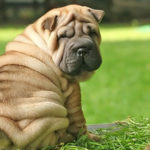The Pug is a breed of dog with a unique and adorable appearance, characterized by its compact body, short legs, and wrinkled face. If you’re new to owning a Pug, it’s important to understand that their care goes beyond just providing a healthy diet, playtime, and exercise. Let’s explore some essential tips for first-time Pug owners.
1. Get to Know the Pug Breed
Origin of the Pug
The Pug, also affectionately known as the Pug Dog or Chinese Pug, originates from China. During the 16th century, they were introduced to Europe, and by the 19th century, they had become the beloved companions of Queen Victoria.
Since then, the Pug’s popularity has continued to grow. In 2004, a Pug even took first place at the World Dog Show, further solidifying its status as a beloved breed.
 The Pug’s Origin
The Pug’s Origin
Common Pug Coat Colors
According to the American Kennel Club standards, Pugs are recognized in two common coat colors: fawn and black.
However, the Federation Cynologique Internationale (FCI) standards acknowledge four colors for Pugs: fawn, black, apricot, and silver. These are the colors you are most likely to encounter.
 Common Pug Coat Colors
Common Pug Coat Colors
Physical Characteristics of the Pug
The Pug’s face is distinguished by numerous wrinkles, round and protruding eyes, a curled tail, and a short muzzle. Their coat is soft and smooth, and they come in a variety of colors as mentioned above.
Pugs have a compact body shape, standing between 26-42 cm tall, and typically weighing between 6-8 kg. They have a stocky and rounded appearance, resembling a bundle of joy.
 Physical Characteristics of the Pug
Physical Characteristics of the Pug
Temperament and Personality
Pugs are highly intelligent and agile dogs that can sense your mood through your tone of voice. They are generally gentle and sociable, but they tend to eat, sleep, and play a lot, which can lead to weight gain. Regular walks and exercise are essential to maintain their health.
Some notable traits of the Pug’s personality include their cheerfulness around children, hospitality to guests, loyalty, and emotional depth. They thrive on attention from their owners and can get jealous if you show more affection to other pets.
 Temperament and Personality
Temperament and Personality
Further Reading:
2. Feeding Your Pug
Nutritional Requirements of Pugs
Whether it’s a Pug or any other dog breed, a balanced diet with adequate protein and fat is essential. Include sources of protein and fat such as meat, organ meats, eggs, various nuts, and canned food. If you’re concerned about a lack of fat in their diet, you can add fish oil, chicken fat, or vegetable oil to their meals.
Pugs are known for their hearty appetites, so it’s easy to incorporate vitamins and fiber from vegetables and fruits like green vegetables, green beans, peas, carrots, sweet potatoes, potatoes, broccoli, zucchini, pumpkin, and various fruits.
 Nutritional Requirements of Pugs
Nutritional Requirements of Pugs
Dietary Needs by Life Stage
For Pugs aged 2 to 3 months
At this stage, Pug puppies are just starting to eat solid food, so it’s best to feed them soft and mashed meals. After each meal, you can offer them warm milk. Aim for four meals a day, evenly spaced apart.

A word of caution: avoid feeding them raw food, bones, shrimp, crab, or fish at this delicate age.
For Pugs aged 3 to 6 months

Pugs at this stage should not be fed bones as their digestive system is still developing. Limit their meals to 2-3 times a day, and include soft foods such as porridge, mashed fruits and vegetables, crab, fish, or minced meat.
For Adult Pugs

Adult Pugs are prone to obesity, so it’s crucial to monitor their food intake as they are greedy eaters. Typically, two meals a day are sufficient to meet their nutritional needs.
3. Grooming and Hygiene for Pugs
When it comes to caring for your Pug’s hygiene, keep the following tips in mind:
Wipe the folds on their face once a week. These folds can trap saliva, dirt, and food particles, causing irritation and an unpleasant odor. Use a cotton swab dampened with warm water to gently clean along the folds around their nose and eyes.

Brush their coat once or twice a week. Pugs tend to shed a lot, so regular brushing with a dog brush or a specialized brush during shedding season will help maintain a healthy coat.
Clean their ears once a week with a special solution. Pug’s ears are prone to accumulating dirt and wax.

Use an ear cleaning solution specifically designed for dogs, and follow up by gently wiping the ears with cotton balls. Be careful not to insert the cotton balls too deeply into the ear canal to avoid causing injury.

Trim their nails regularly. Since Pugs don’t wear down their nails naturally, you’ll need to trim them periodically using dog nail clippers. Be sure to cut below the soft quick, the blood supply to the nail.
Common Health Issues in Pugs
- Breathing difficulties are common in Pugs due to their skull structure, especially in hot weather or after vigorous exercise. If you notice bubbles forming around their nose and mouth, seek veterinary attention promptly.
- Regularly clean their skin, especially the wrinkles, as dirt and bacteria can accumulate and cause skin infections.
- Pugs are prone to eye problems such as dry eye, cataracts, and keratoconjunctivitis, which can lead to blindness if left untreated. Their protruding eyes are also susceptible to injuries from sharp objects.
 Common Health Issues in Pugs
Common Health Issues in Pugs
- Obesity is a common issue in Pugs due to their tendency to overeat. Regular exercise and a balanced diet are crucial to maintaining a healthy weight.
- Like other dog breeds, Pugs can suffer from flea infestations, excessive scratching, and hair loss due to licking or biting their fur.
Important Considerations When Caring for Pugs
Pugs are energetic in short bursts but can quickly overheat due to their flat noses, which makes it challenging for them to cool down. Aim for 1-2 walks per day and incorporate indoor games like fetch or hide-and-seek to keep them active and entertained.

Here are some additional considerations when caring for your Pug:
- Avoid exposing your Pug to extreme weather conditions.
- Use a harness instead of a collar to prevent pressure on their neck.
- Create a dedicated space for your Pug in your home where they can feel safe and comfortable.
- Establish a consistent daily routine for feeding, exercise, and rest.
- Take your Pug for regular check-ups twice a year and ensure they are up to date with their vaccinations.
- Lastly, never leave your Pug unattended, as their curiosity can lead to mischief and unexpected situations.
4. Buying a Pug: What to Know
Price Range for Pugs
- Purebred Pugs: 6-8 million VND.
- Pugs bred domestically: 10-12 million VND.
- Pugs imported from Thai kennels: 12-25 million VND.
- Pugs imported from Europe: 42-60 million VND.
 Price Range for Pugs
Price Range for Pugs
Things to Consider Before Buying a Pug
Before bringing a Pug into your life, keep the following in mind:
- Research Pug prices beforehand to avoid overpaying.
- Seek advice from experienced Pug owners to help you distinguish between purebred and mixed-breed Pugs. Their insights on Pug care and ownership can be invaluable.
- Find a reputable source for purchasing your Pug to ensure the dog’s health and avoid scams.
Knowing the market price for Pugs and understanding the different price points is crucial to making an informed decision. At a minimum, you should be aware of the typical price range for Pugs and the factors that influence their cost.
We hope you found this guide helpful. Wishing you a wonderful day ahead!
Care, and Pricing’>Uncovering the History and Details of the Peruvian Dog: Facts on Origins, Characteristics, Care, and Pricing
Investigating the Features, Maintenance, and Expense of Border Collie Breeds
Experts weigh in on the reasons behind the loving bond between people and Border Collies. Find out why these dogs have earned such a special place in people’s hearts as well as the key characteristics that make them so unique. Plus, get a grasp on the expenses to watch for when taking on the responsibility of owning a Border Collie.
The Shih Tzu Breed: Unveiling the Intricacies of Their Nature and Care
The Shih Tzu is an ancient breed of dog originating from China, and their popularity has recently boomed in Vietnam. With their adorable appearance and affectionate nature, it’s no wonder that many are keen to learn more about this breed, their unique characteristics, and the specific care they require.



































